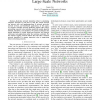1937 search results - page 92 / 388 » Virtual networking |
ANSS
2008
IEEE
15 years 5 months ago
2008
IEEE
—Real-time network simulation refers to simulating computer networks in real time so that the virtual network can interact with real implementations of network protocols, network...
101
click to vote
SENSYS
2006
ACM
15 years 5 months ago
2006
ACM
From experience with wireless sensor networks it has become apparent that dynamic reprogramming of the sensor nodes is a useful feature. The resource constraints in terms of energ...
ISCA
2008
IEEE
15 years 5 months ago
2008
IEEE
Current state-of-the-art on-chip networks provide efficiency, high throughput, and low latency for one-to-one (unicast) traffic. The presence of one-to-many (multicast) or one-t...
ICNSC
2008
IEEE
15 years 5 months ago
2008
IEEE
Today's communication-based applications are mostly crafted in a stovepipe development paradigm, which is inflexible to be used by various domain-specific applications and cos...
ICDCS
2000
IEEE
15 years 3 months ago
2000
IEEE
Group communication, providing virtual synchrony semantics, is a powerful paradigm for building distributed applications. For applications that require a large number of groups, s...


